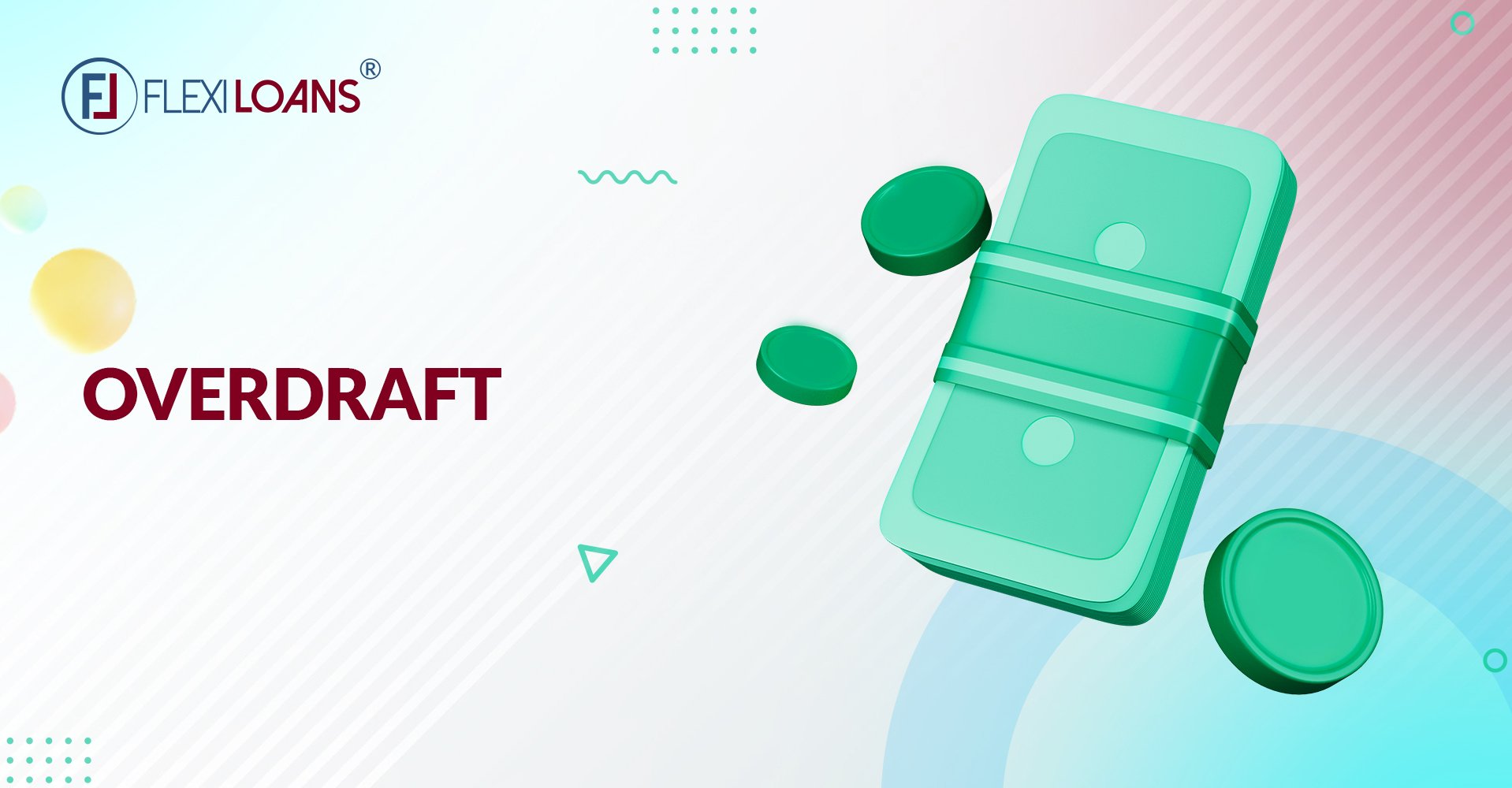Aug 31, 2023

Overview
Sometimes, you might find it difficult to handle a sudden money crunch. When faced with an emergency, you might need some quick cash for a short period. That’s when many individuals turn to their friendly neighborhood financial institutions for a bank overdraft account vis-à-vis their assets. If used wisely, an overdraft account can be a handy tool to cover your immediate financial needs.
In this article, we embark on a journey of acquiring an in-depth understanding of OD Accounts, which come in handy in times of short-term monetary need. We explore the scenarios where even a well-maintained contingency fund may fall short, leaving individuals in search of additional resources to address unforeseen events. Explaining the utility of overdrafts, we shed light on their potential as a viable solution to bridge the gap between immediate financial requirements and available funds.
Definition
The full form of OD is Overdraft Account. It is a credit-based service provided by various financial institutions and banks. This facility grants you the ability to withdraw funds from your Current or Savings Account, even if your account balance is zero. It extends the monetary limit offered by the banks, allowing you to access funds classified as ‘overdrawn’.
The amount you can avail through the Overdraft Account Facility depends on your customer relationship with the respective bank. Once you have this facility in place, you can withdraw funds within the authorised limit. It is important to note that banks levy interest rates on the utilised amount, but these rates are only applicable to the portion withdrawn from the total sanctioned limit.
In essence, the OD Account Facility serves as a short-term loan that requires repayment within a fixed tenure, along with the predetermined interest. It acts as a practical solution for swiftly accessing additional funds during financial emergencies, offering a viable option to address immediate monetary needs.
Features of Overdraft
1. Customised Credit Limit:
The Overdraft Account Facility provides an approved credit limit tailored to each borrower. This limit may vary based on personal circumstances, financial history, and track record.
2. Interest Calculation:
The interest rate is generated daily and the bank adds it to the account balance at the end of the month. In case of default on the scheduled repayment, the interest amount adds to the principal amount, and the bank calculates the subsequent interest based on the revised total.
3. No Prepayment Charges:
Unlike traditional loans, the Overdraft Account Facility does not impose any prepayment fees. You have the freedom to repay the borrowed amount at your convenience, without being bound by Equated Monthly Installments (EMIs).
4. Flexible Repayment:
OD Account can be repaid in terms of any amount paid at any time. There is no obligation to follow a fixed repayment schedule. However, if the lender requests a specific repayment, you must fulfil it accordingly.
5. No Minimum Monthly Payment:
While there is no mandatory minimum monthly repayment, it is crucial to ensure that the outstanding amount remains within the approved Overdraft Account Limit. Prolonged delays in repayment can adversely affect your credit score.
6. Joint Borrower Option:
Applicants can operate Overdraft Accounts jointly, where both applicants share equal responsibility for the entire debt. Regardless of the proportion of funds utilised, both borrowers are accountable for timely repayment. In the event of default, all collaterals of both borrowers are at risk.
7. Overdraft and Cheque Transactions:
It is important to note that writing a cheque does not automatically trigger the Overdraft Account feature. In some cases, the cheque may not go into the Overdraft Account, resulting in associated charges being levied on the account.
Benefits of Overdraft
Here are five reasons to opt for an overdraft loan account
- Gain immediate access to extra funds: Get the financial support you need right away with an overdraft loan account. It serves as a reliable safety net, helping you overcome temporary financial challenges, unexpected expenses, or emergencies.
- Take control of your borrowing: Customise your borrowing experience by setting a maximum limit that suits your needs. With this flexibility, you can determine the exact amount of additional funds required each month. Adjust your spending limit conveniently through self-service channels.
- Pay interest only on what you use: Enjoy the benefit of paying interest solely on the amount you utilise. The interest rate is linked to the prime interest rate, allowing you to potentially benefit from interest rate reductions and optimise your repayment strategy.
- No monthly costs or obligations: Say goodbye to initiation fees, monthly service fees, and mandatory minimum monthly repayments. With an overdraft loan account, you can access the benefits without worrying about additional costs. Maintain eligibility by adhering to your spending limit and making at least one monthly deposit into your current account.
- Secure your finances with insurance coverage: Protect yourself in case you face difficulties repaying the outstanding balance. Consider securing insurance coverage for your Overdraft Account, providing you with an added layer of security and peace of mind.
Eligibility Criteria for Overdraft
The eligibility criteria for an overdraft loan account range from a minimum age of 18 years to a maximum age of 65 years. This short-term credit option offers a repayment period of up to 12 months. The bank assigns a credit limit to the overdraft loan account based on the value of your account, ensuring a tailored borrowing experience.
Documents Required for Overdraft
As previously mentioned, the application process for an Overdraft Account facility is simple, uncomplicated, and devoid of unnecessary hassles. To initiate the process, you need to provide the following documents as proof of identity and address (choose any one from each category):
Proof of Identity:
- Valid Passport
- PAN Card
- Aadhaar Card
- Voter ID Card
- Driving Licence
Proof of Residence:
- Recent Electricity Bill
- Gas Bill
- Valid Passport
- Leave and Licence Agreement
In addition to the aforementioned documents, you have to submit your bank account statements for the preceding three months. This helps the lending institution evaluate your financial standing and determine the feasibility of granting you an overdraft account facility. With these necessary documents in hand, you can confidently proceed with your Overdraft Account application, enjoying a hassle-free experience.
Overdraft Account Vs Cash Credit
What is Cash Credit?
Cash Credit (CC) acts as a valuable lifeline of short-term financial support for businesses and companies. Commonly known as working capital loans, cash credits cater to the immediate cash requirements or enable the acquisition of current assets within organisations. The borrowing limits associated with cash credits may vary across different commercial banks, determining the extent to which you can use cash as credit.
Diverging from conventional loan structures, banks calculate interest on cash credits by assessing the daily closing balance rather than the maximum borrowing limit. Consequently, the repayment obligation solely applies to the utilised amount from the available credit limit. Typically, you obtain cash credits for brief periods, with repayment terms typically set at 12 months or less.
Securing a cash credit entails providing collateral as a safeguard to the lending institution. This collateral serves as a form of assurance for the lender in the event of default. It is essential to note that while cash credits share some resemblances with Overdraft Account facilities, they possess distinctive attributes. Cash credits generally encompass shorter durations and boast significantly lower interest rates compared to overdrafts.
In essence, cash credit plays an instrumental role in providing expedient short-term financing solutions for businesses and companies. Its inherent characteristics of interest calculation methods, repayment terms, and collateral prerequisites make it an invaluable financial tool for organisations in need of swift access to funds.
Cash credit and overdraft exhibit differences across the following dimensions:
1. Interest rates: Cash credit offers the advantage of lower interest rates compared to Overdraft Account facilities. Conversely, Overdraft Accounts entail higher interest rates.
2. Security: Cash credit necessitates the hypothecation of stocks and inventory as collateral. Conversely, you can secure overdrafts based on factors such as financials, credit history, investments, and your relationship with the bank, eliminating the need for specific collateral.
3. Purposes: Cash credit primarily serves specific business purposes such as working capital. In contrast, you can use an OD account for a wide range of general expenses, including those related to business activities.
4. Loan amount: Cash credit determines the sanctioned loan amount based on the value of stocks and inventory. Conversely, Overdraft Accounts determine the loan amount based on financials and security deposits.
5. Limit: Cash credit maintains a consistent limit throughout the borrowing period. On the other hand, overdraft accounts have a diminishing limit that decreases every month.
6. Account: To access cash credit, individuals need to open a new bank account exclusively for this purpose. In contrast, you can access Overdraft Account facilities by using an existing bank account.
7. Tenure: Cash credit typically offers a minimum tenure of one year. Conversely, Overdraft Account Facilities have flexible tenures ranging from one month to one quarter, up to a maximum of one year.
8. Applicants: Cash credit is available to a wide range of applicants including individuals, traders, manufacturers, retailers, distributors, partnerships, companies, sole proprietorships, and LLPs. On the other hand, overdraft account facilities apply only to account holders of the respective banks.
Overdraft Account Vs Business Loans
What is a Business Loan?
A business loan serves as a valuable resource for supporting your company’s growth and financial needs. Whether you’re looking to expand your operations, acquire working capital, invest in new equipment and supplies, improve your infrastructure, stock up on raw materials, or hire and train employees, a business loan may offer the necessary funds.
Business loans come in two types: unsecured and secured. Unsecured loans do not require collateral but typically have higher interest rates. On the other hand, secured loans necessitate providing collateral equivalent to the loan amount.
These loans enable you to borrow significant sums of money from lenders, which you repay through Equated Monthly Installments (EMIs) comprising both the principal amount and interest. Several factors influence your eligibility for a business loan, including your profile, years of experience, financial status, business history, credit history, and credit score.
By accessing a business loan, you can obtain the financial resources needed to propel your business forward, seize opportunities, and achieve your goals. It offers a flexible and structured approach to managing your company’s financial requirements effectively.
Let’s explore these financial products in greater detail to assist you in making an informed decision:
1. Loan Amount:
A business loan provides a convenient option for borrowing significant amounts as it offers a lump sum upfront. On the other hand, Overdraft Accounts function similarly to credit card purchases, enabling business owners to withdraw funds from a specific account daily, according to their immediate requirements.
2. Interest Rates:
Generally, Overdraft Accounts tend to have higher interest rates compared to business loans. However, an overdraft only charges interest on the amount withdrawn, rather than the entire credit limit. In contrast, a business loan accrues interest on the entire borrowed amount, regardless of its utilisation.
3. Duration:
Overdraft Accounts typically have shorter sanction periods, often lasting around a year. You will need to renew the account at the end of the tenure to continue utilising the facility for the subsequent year. Business loans, on the other hand, are available for more extended periods, subject to the specific requirements set by the lender.
4. Usage:
An Overdraft Account Account is well-suited for fulfilling day-to-day working capital needs such as managing inventory and paying salaries. In contrast, a business loan provides a suitable option for more substantial investments including the purchase of machinery, business expansion, and acquiring commercial property.
5. Flexibility of Repayments:
Overdrafts offer greater flexibility in terms of repayments. You have the option to deposit an amount equivalent to the withdrawn sum to repay the Overdraft Account. Conversely, business loans are typically repaid through EMIs. Failure or delay in EMI payments may impact your ability to obtain new credit in the future.
Both types of business credit, while sharing similarities, serve distinct purposes. When in need of funds for your business, you can choose between an Overdraft Account, a business loan, or even consider utilizing both options, depending on your specific requirements and financial circumstances.
To understand whether a business loan or overdraft will suit you the best, Click here.
Overdraft Account Facility Offered by FlexiLoans
Introducing FlexiLoans: Your Solution for SME Financing
Are you a Small and Medium Enterprise (SME) struggling to secure a loan? Look no further than FlexiLoans, an Indian fintech company specialising in offering hassle-free MSME loans and loan-related services to SMEs through an innovative online platform. Traditional bank loans can be challenging to obtain for SMEs due to limited credit history, collateral requirements, and lengthy approval processes. FlexiLoans understands these challenges and has tailored the services to cater specifically to your financing needs.
With FlexiLoans, you can enjoy the benefits of a unique overdraft loan account facility. Unlike traditional loan structures, Flexiloans’ overdraft loan accounts offer a combination of account balance evaluations, pre-approved loan offers, and the utilisation of diverse assets as collateral such as bank fixed deposits, equities, and bonds.
One of the key advantages of FlexiLoans’ overdraft loan accounts is the flexibility they offer. You have the freedom to choose between full and partial repayment at your discretion. This adaptable approach sets it apart from conventional loan arrangements.
FlexiLoans also provides overdraft protection, ensuring that your cheques, ATM transactions, wire transfers, or debit card transactions clear even if your account balance falls low.
Unlock your business potential with FlexiLoans! Don’t let traditional loan limitations make you hold your business dreams back! Choose FlexiLoans and experience a seamless, flexible, efficient, and hassle-free way to access the funds your SME needs today!
Visit our website to learn more and apply now! Empower your business with FlexiLoans.
Takeaways
As you reflect on the concept of an Overdraft Account, remember the key factors. Overdraft Account offers the flexibility to access funds when you need them, providing a lifeline for your business operations. It empowers you to manage day-to-day working capital needs and seize growth opportunities. However, it’s crucial to carefully consider interest rates, repayment terms, and the impact on your future creditworthiness.
By understanding the benefits and potential risks, you can harness the power of overdraft to fuel your business ambitions and navigate the ever-changing financial landscape with confidence.
Frequently Asked Questions
Q. 1 How can an overdraft loan account benefit your business?
Ans: An overdraft can be a valuable tool for your business in several ways. It helps maintain business solvency, allowing you to safeguard cash flow disruptions from external factors. Additionally, it serves as a reliable solution for covering unexpected business expenses, providing the necessary financial support when you need it most.
Q. 2 Is a bank overdraft considered an asset or liability?
Ans: Banks classify an overdraft as a current liability, as it is payable within the accounting period. Overdrafts reflect on the liability side of a balance sheet, showing the financial obligations of the business.
Q. 3 Are overdraft loans advantageous or disadvantageous?
Ans: Overdraft Account loans can be highly advantageous when managing short-term financial requirements. They offer flexibility and ease of access during financial emergencies. With an overdraft loan, you only pay interest on the amount used, regardless of the credit limit sanctioned. This makes it a practical solution for handling temporary cash flow challenges.
Q. 4 Does a bank overdraft result in a negative balance?
Ans: Yes, an overdraft, also known as a bank overdraft, occurs when the total amount of cheques presented for payment exceeds the available deposit balance. In such cases, the bank account will have a negative balance until the cheques are cleared.
Q. 5 Does an overdraft incur interest?
Ans: Typically, when you have an arranged overdraft with your bank, you may have to pay interest for utilising it. It is important to request an arranged overdraft from your bank if you wish to have this facility on your account.
Q. 6 Why is interest on a bank overdraft debited?
Ans: Interest on a bank overdraft will debit from the bank passbook because it represents a charge imposed by the bank. This reduces the balance in the bank passbook. Businesses consider interest on a bank overdraft as an expense, which is credited in the cash book upon payment and debited in the Profit and Loss account when preparing the final accounts.
Q. 7 Is a bank overdraft classified as a type of loan?
Ans: A bank overdraft is a form of short-term financing available to bank account holders. While it shares similarities with loans such as providing financial assistance during a crisis, banks do not classify it as a traditional loan like a home loan, business loan, or personal loan.
Q. 8 How is a secured loan different from an unsecured loan?
Ans: Secured loans require collateral or security to secure the loan amount, while unsecured loans do not require any guarantee. Collateral serves as a form of protection for the lender in the case of default or non-repayment.
Q. 9 Does an Overdraft Account Facility fall under the loan category?
Ans: Yes, an Overdraft Account Facility is a type of loan provided by banks to customers during financial crises. It proves particularly useful for managing end-of-month cash flow challenges and making timely payments for utility bills or credit card dues.
Q. 10 Which institutions provide an Overdraft Loan facility to individuals and businesses?
Ans: In the past, Overdraft Loan Accounts were exclusively provided by banks to cater to the cash flow needs of businesses. However, with changing times, Non-Banking Financial Companies (NBFCs) have also embraced this product to serve their consumers. Surprisingly, even individuals now have the opportunity to access this valuable service, expanding the options available for Overdraft Loan Accounts.







